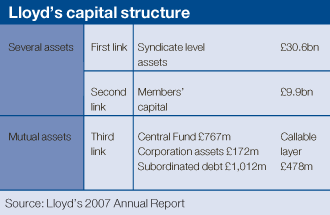Review
The business – Amlin London
Market overview
Lloyd’s is the world’s leading specialist insurance market, with 80 syndicates and gross written premium of over £16 billion in 2007. Lloyd’s accounts for approximately two-thirds of the London insurance market and retains prominent market positions in reinsurance, property and casualty, marine and aviation insurance.
The Lloyd’s structure is unique. Members of Lloyd’s, such as a number of Amlin subsidiaries, provide capital to support syndicates. This member capital is only available to meet claims from policies written for that member. However, if that capital is exhausted, then any residual losses may be met out of mutual assets held by the Corporation of Lloyd’s. This ‘chain of security’ provides excellent security to policy holders and capital efficiency to members.

The financial strength of Lloyd’s is rated by leading rating agencies as follows:
– AM Best: A (Excellent), stable outlook;
– Fitch Ratings: A+ (Strong), stable outlook;
– Standard & Poor’s: A+ (Strong) stable outlook.
One of the attractions of Lloyd’s is its licensing network. While reinsurance can be written unlicensed in most territories, Lloyd’s network of licences allows syndicates to write insurance in more than 200 different countries. Importantly, Lloyd’s is the second largest market for ‘surplus lines’ US insurance: that is complex, or higher risk, US insurance that cannot be covered in the more regulated ‘admitted’ insurance market.
Lloyd’s is predominantly a subscription market. The nature of this market, where one company will take a proportionate share of a contract rather than underwriting the whole, allows effective placement of large and complex risks. It also allows clients to reduce counterparty risk by spreading the placement of their (re)insurance across a number of different insurance carriers.
At a practical level, a lead underwriter in the market, through negotiation with a broker, sets the terms and conditions of the (re)insurance policy. Amlin leads 47% of its London market subscription business. Acting as lead participant is desirable in that we have greater influence over the pricing and contract terms and will generally have a closer relationship with the insured client. The broker then negotiates support from other underwriters, known as followers, until the contract is fully subscribed. Once a policy is placed in Lloyd’s, processing of accounting and tax transactions are dealt with centrally by common service providers across the whole market.
From a claims perspective, the leading (re)insurer handles the claim advice from the client and directs any necessary investigation and final settlement. This process is overseen by a peer reviewer; a service currently provided by a common service provider.
The Lloyd’s market has been operating since the 17th century. It has the advantage of a mature distribution chain of dedicated brokers, who understand Lloyd’s product offerings and know how to access the expertise in the market. Most Amlin London business is sourced through global brokers operating in the London subscription market. 50% of this business is sourced by the three largest brokers, as shown in the chart below.

However, the market’s status is not unchallenged. The Bermudian reinsurance market has grown substantially over the last 25 years and is a strong competitor for reinsurance business.
Equally, while one of the market’s strengths is its mature broker distribution, for more standard or small insurance business the complex placement process and infrastructure makes it more difficult, and expensive, to access. Historically, only Lloyd’s brokers have been able to deal with Lloyd’s syndicates. However, this has been addressed in a recent legal change and it is now possible for non Lloyd’s brokers to place risk directly with a Lloyd’s syndicate. The challenge for the future will be to make this happen.
Another developing phenomenon has been the emergence of significant local insurance markets. These present a risk to the flow of business to London but also a challenge for Lloyd’s as to how best to access them. Singapore is a good example in this regard, with the Singaporean authorities determined to develop Singapore into an Asian insurance hub. The establishment of Amlin Singapore in November 2007, operating through the Lloyd’s Asia platform, has allowed us to source new business to our existing syndicate in London in a capital efficient manner. We expect to consider further opportunities in local markets such as the Middle East and South America as part of our ongoing business development, working within the Lloyd’s framework where appropriate.
